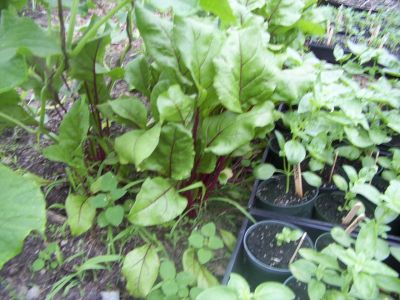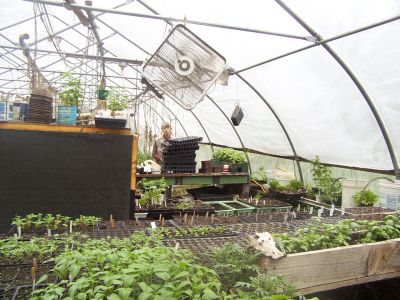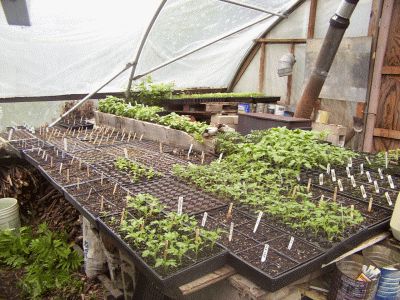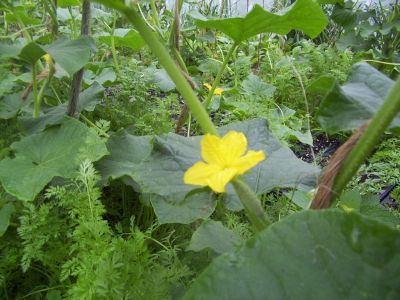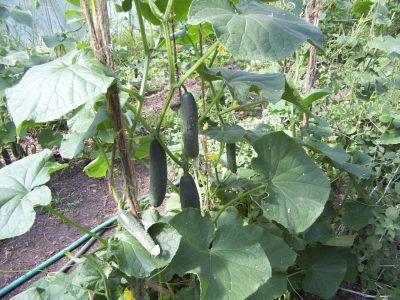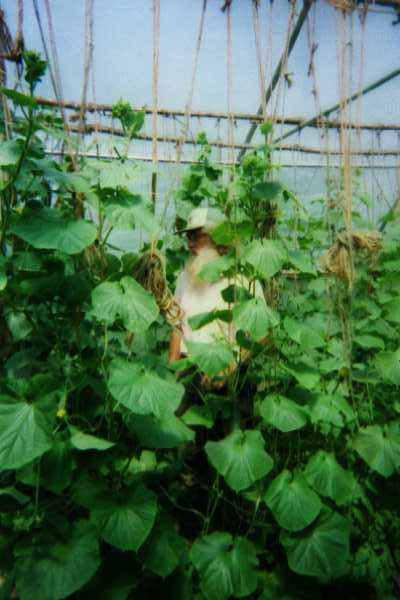Three Season Growing
in an Organic Greenhouse
at Snakeroot Organic Farm
by Tom Roberts
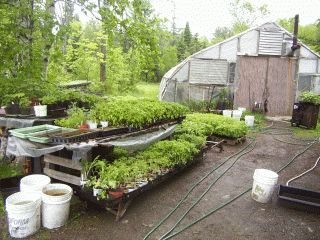 The big greenhouse, or GH1. 27′ x 96′, metal bows, heated, 1997. |
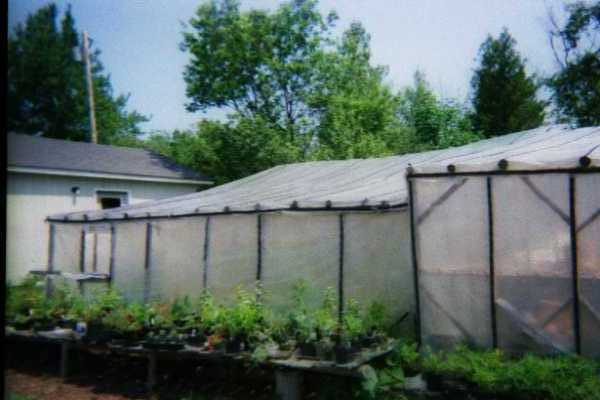 The wooden greenhouse, or GH2. 22′ x 22′, wood poles, unheated, 2001. |
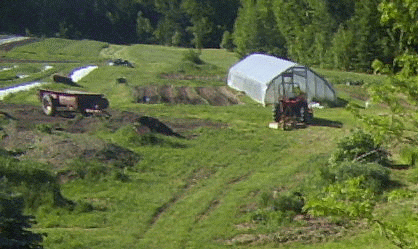 The third greenhouse, or GH3. 14′ x 60′, metal bows, unheated, 2001. |
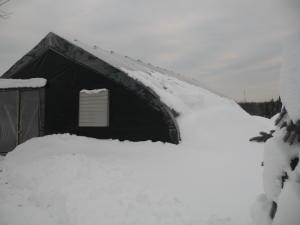 The fourth greenhouse, GH4, 27′ x 48′, metal bows, unheated, 2006. |
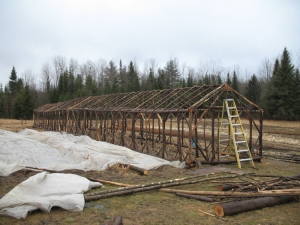 The fifth greenhouse, GH5. 14′ x 100′, wood poles, unheated, 2007. |
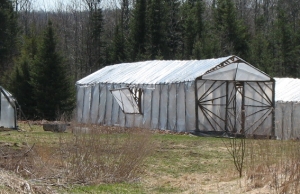 The sixth greenhouse, GH6. 14′ x 60′, wood poles, unheated, 2007. |
| Also see the Crop Rotations page where greenhouse crop rotations are discussed.
|
|
|
At Snakeroot Organic Farm we have six greenhouses, one heated and five unheated. In them we grow various veggies in succession plantings from March to November. Our first and largest greenhouse (GH1) is a 27′ x 96′ commercial Stuppy greenhouse, the second (GH2) is a homemade 22′ square cedar pole frame greenhouse covered with recycled greenhouse plastic, the third (GH3) is an Ed Person 14′ x 60′ commercial (metal frame) greenhouse. GH4 is a commercial metal frame greenhouse 27′ x 48′, and although it is generally used unheated, we do have a barrel stove in it to ward off frosts in late April and May when we’ve planted it with early cukes or tomatoes. GH5 (14′ x 100′) and GH6 (14′ x 60′) we built one spring when we had cut an abundance of spruce poles that winter. They are both covered with recycled greenhouse plastic and neither is heated. Only our first greenhouse (GH1) is heated. For that we use a 130,000 BTU Benjamin wood furnace at one end and a barrel stove at the other end, which we fire up on those really chilly nights. When the nighttime temperature is falling below 20°F I set up a mattress atop the bags of potting soil and spend the night to better keep the furnace and stove stoked every three hours. Aside from the ½ HP fan in the furnace, we hang two household window exhaust fans from the trusses on one side to keep the air moving. These we turn on in March and turn off in November. In-ground raised beds comprise about two-thirds of GH1; the other third is reserved for the seed starting, transplanting, and potting operation. The beds are rejuvenated every year by hauling in and spreading buckets of compost which is then rototilled in with a small Troy-Bilt Bronco tiller. Between the beds, the aisles are mulched with shredded leaves, applied each year shortly after trellising begins and the early spring crop is all harvested. GH1 is unheated from November to March. When we turn the heat off in November everything freezes at night, which marks the beginning of fall greenhouse cleanup. We pull down the trellised plants, haul all the vines to the compost pile, and prepare the beds for their next plantings. There are seven raised beds, and the two edge beds (Bed Numbers 1 & 7) have garlic planted in them in December. We choose the two outer beds because there isn’t as much trellising headroom there, and because—being next to the greenhouse walls—those beds are cooler, which garlic doesn’t mind. The garlic usually begins to emerge well before the greenhouse heating season begins. The rest of the in-bed growing season gets under way when we plant beet greens, carrots and a few hakurei turnips in February in the middle five raised beds. We have to wait for a nice sunny day and plant in the afternoon so the beds will be thawed enough to plant in. The seeds take a few weeks to emerge, and once they do they grow very slowly until we begin to heat the greenhouse. We have chosen those crops both because they don’t mind freezing as tiny seedlings, and they don’t bolt during hot April days in the greenhouse the way lettuce, spinach and radishes will. We have tried spinach, radishes, and lettuce, and while they grow well, the length of their picking window before they bolt is too short. Therefore, we have been growing them in the unheated greenhouses with good results, as they are more cold tolerant than carrots and beets, which means they will actually do more growing when the temperature hovers around 40° to 50°F. The cold nights helps keep them from bolting, but we still have to remember to keep the doors open in the unheated greenhouses unless the weather is close to freezing. Once GH1 begins to be heated, we start tomatoes and cukes in flats to be transplanted into the greenhouse beds in April, as well as all of the early starts for field planting, like peppers, parsley, celery, celeriac, and early broccoli, each on its own schedule. Now the beets and carrots in the beds really take off. When the transplants are ready to go into the beds in early April, we are faced with the problem that the carrots and beets are so big that the ground is pretty much invisible. So our harvesting efforts must be directed to opening holes in the canopy where we can transplant cukes (some years) or tomatoes (other years). Within about two weeks of transplanting, the plants need to be trellised, as they are becoming tall enough to start tipping over. We wind sisal baling twine around the plants, barber pole fashion, leaving the ends loose. That is, we don’t tie a knot around the transplant’s stem. The twine is tied to the greenhouse superstructure. A local organic dairy farmer supplies us with all the baling twine we can use, and each trellis string lasts several years. At the same time, the heated greenhouse is also used for starting all our field seedlings: broccoli, cabbage, herbs, celery, winter & summer squash, cukes, onions, lupines, peppers, eggplant, and tomatoes. Although we can move some frost hardy seedling out of the greenhouse by early May, this still leads to quite a traffic jam for most of the month of May. We need enough room to be able to water everything, to trellis the cukes or tomatoes, harvest carrots and beet greens, and move flats to the garden for planting, and to keep on starting transplants. Late May and June is a time of transition and constant transplanting, moving flats and pots around and out of the greenhouse, and trellising tomatoes or cukes. Trellising begins with the most precocious plants in each row, and continues as others reach the “tipping over height” of around 18 inches. Trellising will now take up several hours each week until August, when the plants grow too tall to reach. They are then allowed to bend over and head back down. Without trellising, tomatoes and cukes take up a much greater area per plant, and greenhouse space, being expensive, is at a premium. Untrellised plants are also more difficult to harvest, as the fruits hide under the leaves. In a trellised system, where you can walk on both sides of the plants, no fruit can hide and harvest is accomplished without bending over, at least not too much. By mid June for cukes, or mid July for tomatoes, greenhouse harvest begins again. The first week we get about a half bushel twice a week, then for several weeks it is a bushel twice a week. These are weeks where there is high market demand so we receive premium prices for these early crops. The system is far from perfect. We still have several problem areas, and we are still working on tweaking the management of our in-ground greenhouse production. The first problem is that the carrots and beet greens growing in GH1 are usually completely harvested by early June, yet the field crops—planted in late April—have yet to reach harvestable size. This leaves an undesirable gap in our production. So we either need to get the field crops to come in sooner or dedicate more greenhouse space to their production. Another problem is that growing a fall crop of cukes or tomatoes means sometime in July we need to remove plants that are still producing, but aren’t as important now that the field crops are coming in. If we don’t get the fall crop planted early enough in the summer, then fall production is minimal, especially so since the days shorten considerably after early October. In fact, we have pretty much given up trying to extend the tomato our cuke season into the fall primarily due to low productivity. We have tried transplanting beans into the beds in late July, but September yield was barely worth the effort. Instead, we have discovered that chard and celery do really well in the unheated fall greenhouses, and their season can be extended a month beyond the point when the cold has killed the field crops. White stem chard will even overwinter producing a good crop for a short time in late April and May. So we are now following early greenhouse cukes with chard and celery. For irrigation, we have all the beds on drip tape from June to October while the tomatoes, peppers or cukes are growing. We pull out the tape each year during the November greenhouse cleanup, and put it back in place once the beds are tilled and planted. As the year begins we first water by watering can, then by hose once the well line has thawed. The disadvantage to hand-watering of course is the time it takes, but the flip side is that it allows the waterer to slowly walk the aisles and see how things are doing, monitor pest pressures, estimate harvest times, etc. Once the beets and carrots are all gone, we roll out the drip tape again for the year. We understand that we have created a unique ecological niche in this greenhouse, one which is far separated in season from the one just outside the walls, but one which is also physically connected to it’s surroundings once the outside season catches up and the doors remain open for ventilation. We allow some weeds to grow all season long, although we try to pull them before they go to seed. We typically have goldenrod, foxtail, field sorrel, lamb’s quarters, jewelweed, chickweed, anise hyssop and poppies as weeds. This is our attempt to maintain a certain “wildness” in the greenhouse, the better to maintain pest/predator populations year round. Although we have had no aphid problems in the greenhouse, we have had difficulties with two spotted spider mites, white flies, and of course cucumber beetles. (We have cucumber beetles in May!) Spider mites have been kept in check very well by purchase and release of predatory mites every three or four years. We have had limited success in controlling white flies with encarsia wasps and delphastus beetles. The cucumber beetles we hand pick in the cool parts of the day, sometimes several times a day. This year we are going to incorporate Hb nematodes and beauvaria fungus in the soil to attack the larvae. |
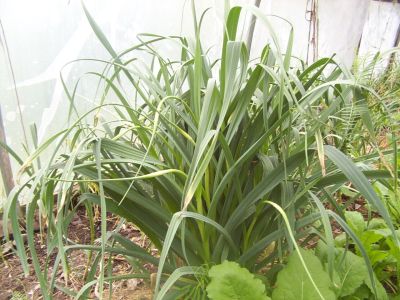 Garlic scapes beginning in May. By early June we are selling garlic scapes; by July we are selling garlic bulbs.
|
